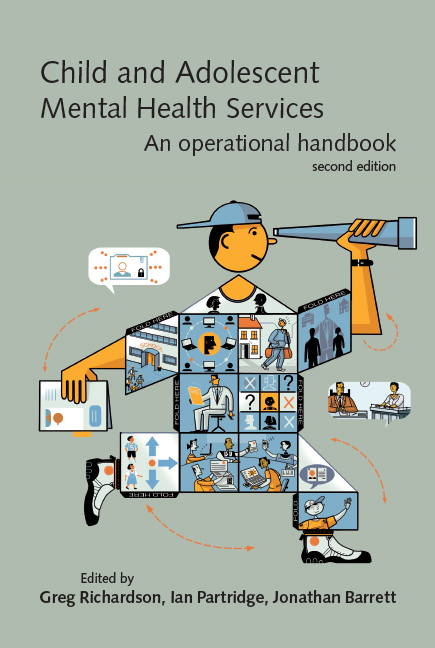Book contents
- Frontmatter
- Contents
- Tables, boxes and figures
- Contributors
- Abbreviations
- Preface
- 1 Introduction
- 2 CAMHS in context
- 3 CAMHS and the law
- 4 Structure, organisation and management of CAMHS
- 5 Evidence-based practice
- 6 Clinical governance
- 7 Education, supervision and workforce development
- 8 Multidisciplinary working
- 9 User and carer participation and advocacy
- 10 A comprehensive CAMHS
- 11 Referral management
- 12 Demand and capacity management
- 13 Strategies for working with Tier 1
- 14 Structuring and managing treatment options
- 15 CAMHS in the emergency department
- 16 Paediatric liaison
- 17 Self-harm
- 18 Learning disability services
- 19 Services for autism-spectrum disorders
- 20 Attentional problems services
- 21 Eating disorder teams
- 22 Bereavement services
- 23 CAMHS for refugees and recent immigrants
- 24 CAMHS and looked-after children
- 25 Drug and alcohol teams
- 26 Parenting risk assessment service
- 27 Court work
- 28 Tier 4 options
- 29 In-patient psychiatric care
- 30 Forensic services
- 31 Neuropsychiatry and neuropsychology services
- 32 Mental health provision for deaf children: study of a low-incidence service provision
- 33 Chief Executives – what do they want and how do they get it?
- Index
33 - Chief Executives – what do they want and how do they get it?
- Frontmatter
- Contents
- Tables, boxes and figures
- Contributors
- Abbreviations
- Preface
- 1 Introduction
- 2 CAMHS in context
- 3 CAMHS and the law
- 4 Structure, organisation and management of CAMHS
- 5 Evidence-based practice
- 6 Clinical governance
- 7 Education, supervision and workforce development
- 8 Multidisciplinary working
- 9 User and carer participation and advocacy
- 10 A comprehensive CAMHS
- 11 Referral management
- 12 Demand and capacity management
- 13 Strategies for working with Tier 1
- 14 Structuring and managing treatment options
- 15 CAMHS in the emergency department
- 16 Paediatric liaison
- 17 Self-harm
- 18 Learning disability services
- 19 Services for autism-spectrum disorders
- 20 Attentional problems services
- 21 Eating disorder teams
- 22 Bereavement services
- 23 CAMHS for refugees and recent immigrants
- 24 CAMHS and looked-after children
- 25 Drug and alcohol teams
- 26 Parenting risk assessment service
- 27 Court work
- 28 Tier 4 options
- 29 In-patient psychiatric care
- 30 Forensic services
- 31 Neuropsychiatry and neuropsychology services
- 32 Mental health provision for deaf children: study of a low-incidence service provision
- 33 Chief Executives – what do they want and how do they get it?
- Index
Summary
‘He who has never learnt to obey commands cannot be a good commander.’
Aristotle, 4th century BCA little on structure
The concept of the Chief Executive is still relatively new in the 60-yearold NHS. Arguably, the role is merely another stage in how services are developed, led and delivered as it has evolved from different types of management systems.
The first model was the medical control of services through medical superintendents supported by matrons. This changed with the establishment of co-equal ‘hospital management teams’ – comprised of a doctor, a nurse and an administrator. This was followed by general management, with the implementation of the Griffiths (1983) report. Finally, for the moment at least, the development of the concept of corporate management through the Boards of Directors of NHS trusts and primary care trusts. The emergence of NHS foundation trusts has seen, alongside Boards of Directors, the requirement of foundation trusts to have a membership drawn from the communities they serve. Foundation trusts also have a Board of Governors, the majority of whom are elected from the membership. The Board of Governors, among other things, hire (or fire) the non-executive directors of the Board of Directors. Foundation trusts are set up as ‘mutual’ organisations such as those in the cooperative movement. They receive their ‘terms of authorisation’ from Monitor, an independent regulator of foundation trusts set up by Parliament. The terms of authorisation describe each foundation trust as a public benefit corporation. Foundation trusts are outwith the control of the Department of Health and their local strategic health authority. They report quarterly to Monitor against a number of indicators. If these indicators indicate good organisational performance, foundation trusts are left alone to manage their own affairs.
The wider landscape
All NHS Chief Executives are the ‘accountable officer’ of the organisation in which they work (Monitor, 2008). To this effect, a memorandum is signed by each Chief Executive describing their personal responsibilities and obligations. Chief Executives are therefore responsible for the overall performance of their organisation. Things can go wrong, sometimes suddenly. In extreme circumstances, the Chief Executive is the first to walk the plank, often followed by the rest of the Board of Directors. When this happens, it is rare for others such as senior clinicians to get a P45 as quickly.
- Type
- Chapter
- Information
- Child and Adolescent Mental Health ServicesAn Operational Handbook, pp. 309 - 314Publisher: Royal College of PsychiatristsFirst published in: 2017



